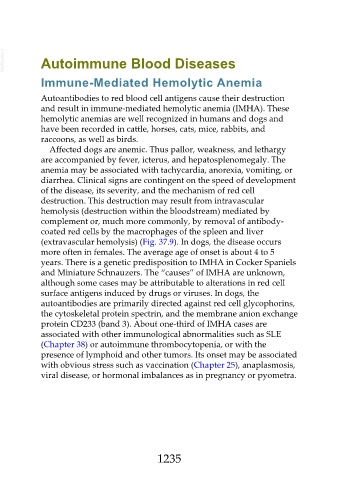Page 1235 - Veterinary Immunology, 10th Edition
P. 1235
VetBooks.ir Autoimmune Blood Diseases
Immune-Mediated Hemolytic Anemia
Autoantibodies to red blood cell antigens cause their destruction
and result in immune-mediated hemolytic anemia (IMHA). These
hemolytic anemias are well recognized in humans and dogs and
have been recorded in cattle, horses, cats, mice, rabbits, and
raccoons, as well as birds.
Affected dogs are anemic. Thus pallor, weakness, and lethargy
are accompanied by fever, icterus, and hepatosplenomegaly. The
anemia may be associated with tachycardia, anorexia, vomiting, or
diarrhea. Clinical signs are contingent on the speed of development
of the disease, its severity, and the mechanism of red cell
destruction. This destruction may result from intravascular
hemolysis (destruction within the bloodstream) mediated by
complement or, much more commonly, by removal of antibody-
coated red cells by the macrophages of the spleen and liver
(extravascular hemolysis) (Fig. 37.9). In dogs, the disease occurs
more often in females. The average age of onset is about 4 to 5
years. There is a genetic predisposition to IMHA in Cocker Spaniels
and Miniature Schnauzers. The “causes” of IMHA are unknown,
although some cases may be attributable to alterations in red cell
surface antigens induced by drugs or viruses. In dogs, the
autoantibodies are primarily directed against red cell glycophorins,
the cytoskeletal protein spectrin, and the membrane anion exchange
protein CD233 (band 3). About one-third of IMHA cases are
associated with other immunological abnormalities such as SLE
(Chapter 38) or autoimmune thrombocytopenia, or with the
presence of lymphoid and other tumors. Its onset may be associated
with obvious stress such as vaccination (Chapter 25), anaplasmosis,
viral disease, or hormonal imbalances as in pregnancy or pyometra.
1235

